You’ve decided: it’s time for you to own a Jazzmaster. You’ve seen lots of people playing them in so many different bands, and you’re excited about how versatile they can be. You’ve never owned one before and so you’ve started shopping around.
You’ve come across a lot of Jazzmasters, haven't you?
How are you going to settle on just one of them? Which is right for you?
Well, I can certainly help. I’ve put this guide together for you today so that you can have all the info you need in one place. From top-end Fender Custom Shop guitars to ultra-affordable Squier models, I’ll cast an objective eye over the Jazzmasters that are currently available, and help you decide which one might be the best for you. This is not a rundown of everything that exists: it’s a specific, curated collection of what I feel to be the best guitars around, at all of the major price points.
To me, it’s not about money or a specification list as much as it is about connection. Lots of factors come into defining such a thing, so use this blog today for info and let it help guide you towards your ultimate Jazzmaster!
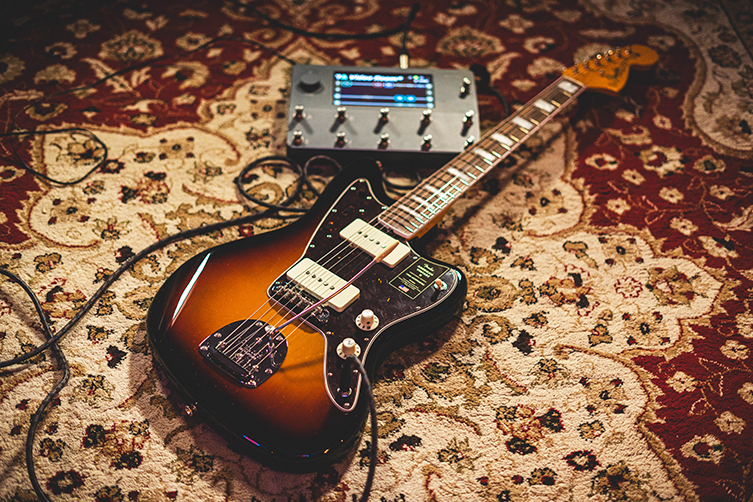
Contents
What is a Fender Jazzmaster?
Firstly, a little rundown on just what the Jazzmaster actually is.
The Jazzmaster was designed by Leo Fender in 1959, and intended to be a more upmarket option for guitarists. It introduced a new ‘offset’ body shape, which has gone on to become a nickname for both it and similar models. Without beating about the bush, the Jazzmaster was designed to get people away from the Gibson Les Paul. It cost more than either the Stratocaster or the Telecaster, and had features built into it that were intended to put it at the exclusive end of the market.
I’ll get to those features in a second, but without taking up too much space on history, the model initially didn’t find a huge audience. The guitar was actually discontinued in 1980 due to low sales. Because of this, lots of young players looking for cheap guitars found Jazzmasters (and their sibling guitar, the Fender Jaguar) in pawn shops, selling for much less than other more desirable models. These players ended up playing in bands like Sonic Youth, Television and My Bloody Valentine, changing the face of guitar music as they went. These bands put Fender offsets back on the map, followed by Kurt Cobain and the grunge movement.
Nowadays, Jazzmasters are massively popular with guitarists from a variety of musical backgrounds, though it’s fair to say that there is a more ‘indie-rock’ connotation with the model than anything else.
So, what were those features?
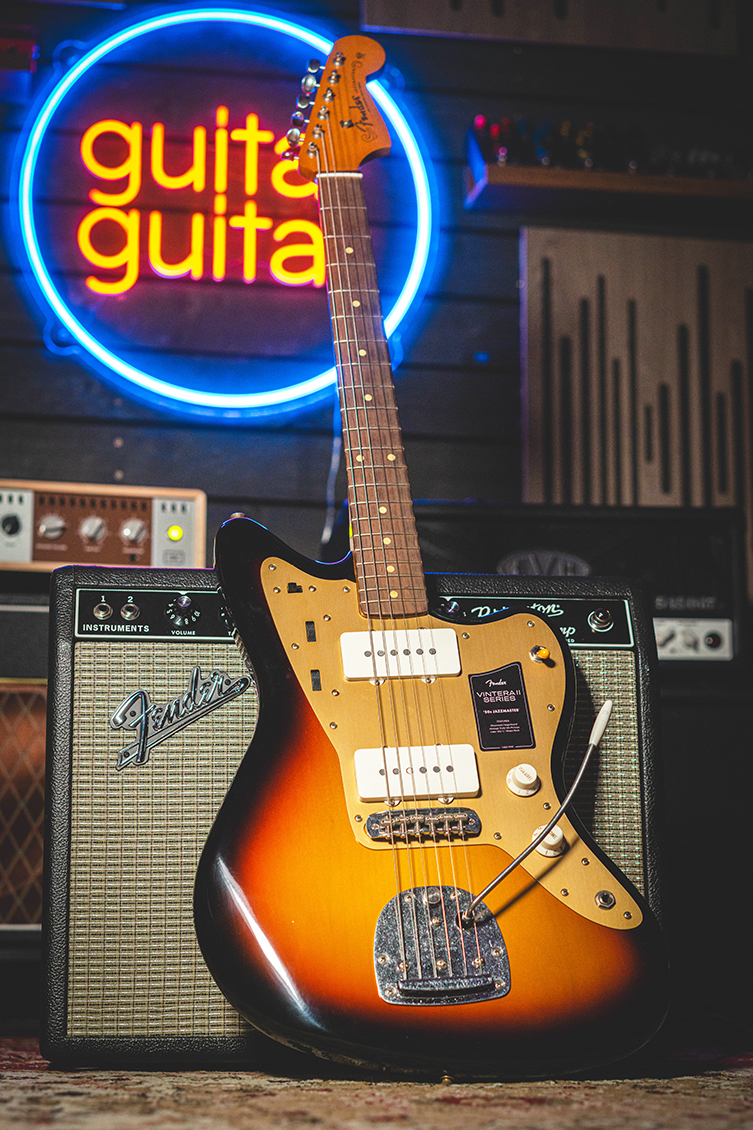
The Special Features of a Fender Jazzmaster
Briefly, here are the things you’ll find on all classic/vintage Jazzmasters, and on many (not all) contemporary models:
- Offset body: this means that the ‘waist’ of the guitar is not symmetrical. It sounds minor, but in fact this makes the whole guitar sit differently on your lap.
- Twin/dual circuit: the Jazzmaster has two independently functioning circuits for sound: one for lead and another for rhythm. In simple terms, the upper thumbwheels control the rhythm circuit, and the lower pickup selector and volume/tone knobs control the lead circuit. You chose between the two via the small mini toggle switch next to the thumbwheels in the upper horn. Each circuit has its own signal path and the tones are pretty distinct.
- Large single coil pickups: visually similar to a P90 pickup, the Jazzmaster pickup is in fact more like a regular single coil pickup in design, but with larger, longer copper windings. What you get is a sound that sits somewhere between a Strat pickup and a humbucker, though in reality, it has its own sound.
- Unique bridge and tailpiece: Well, unique to the Jazzmaster and Jaguar, anyway! The Jazzmaster tailpiece holds the tremolo arm, and is set a fair distance back from the bridge, giving lots of ‘dead string space’ than can be taken advantage of in creative ways. The bridge itself is a famously marmite design: the multiple ferrules within the saddles can prove to be challenging for some players, to the extent that some prefer to replace the bridge with a different style altogether.
- Long tremolo arm: because the tailpiece is set so far back, Jazzmasters have extremely long tremolo arms. This has given way to many innovative playing techniques, not least the ‘glide guitar’ technique pioneered by Kevin Shields of My Bloody Valentine.
So, those are the main features of the Jazzmaster. There are more, but it's time for us to look at some specific guitars! I’ll begin at the top and work my way down to the most affordable - but still very worthwhile - Jazzmaster models.
Fender Custom Shop 1959 Jazzmaster Journeyman Relic
If you want an absolute top-class Jazzmaster, this gorgeous Custom Shop 1959 Journeyman Relic needs to be your first choice. Everything about this guitar is champagne, from the ash body (you hardly ever get Jazzmasters with ash bodies!), handwound pickups and a riftsawn neck.
What is riftsawn? Riftsawn means that the maple log is cut with the grain running perpendicular to the sawblade. This makes the resulting neck stronger than standard necks, and it’ll have a very uniform appearance, too.
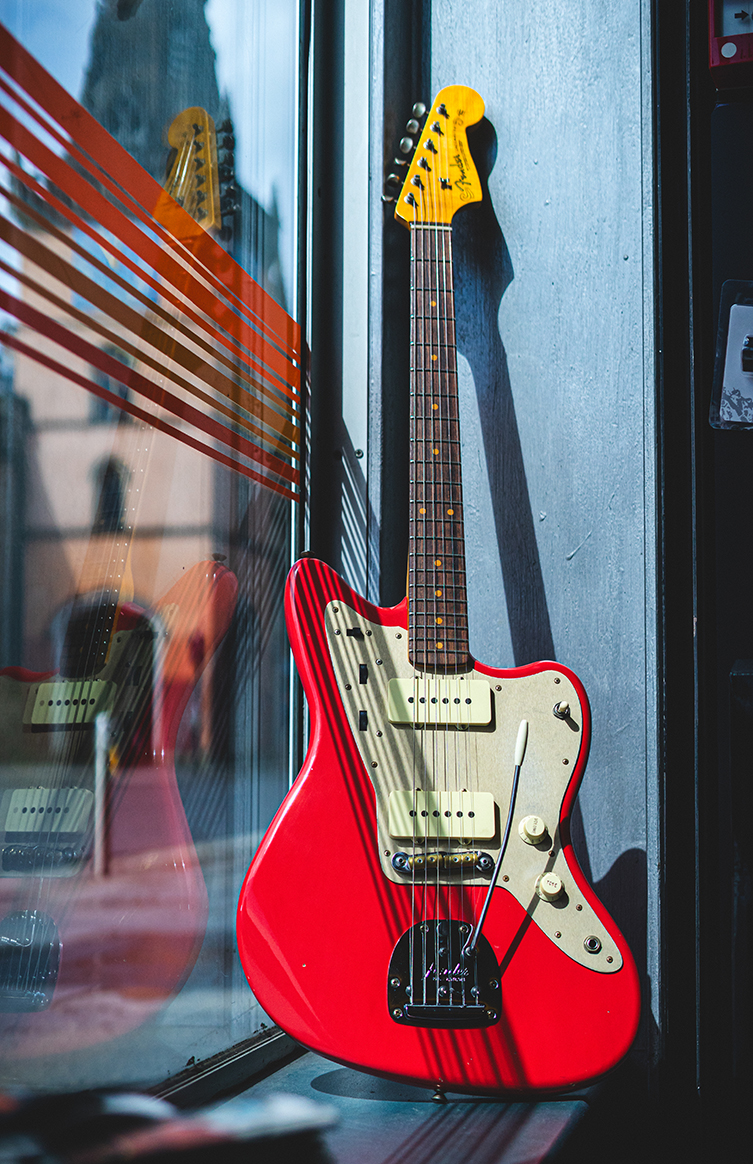
Extra details abound: there’s a Fender RSD bridge on here, which is much more practical than those marmite historical bridges; the fingerboard has a 9.5” radius for a less compromised playing experience; and the journeyman relic finish is a real masterclass in painstaking cracking and checking that will definitely impress.
If you are looking in this price range, you have to check this one out!
American Vintage II 1966 Jazzmaster
Fender’s American Vintage II collection of instruments brings some specifically retro features to a range of guitars that are super-cool. The American Vintage II 1966 Jazzmaster is, as you’d expect, a replica of a vintage 60s model. You get certain features on here that you may not find on other new Jazzmasters. Like what? Like these things…
- Painted headstock to match the body (with most finishes)
- Binding around the fingerboard
- Round-laminated rosewood fingerboard with block inlays
- Pure Vintage 66 pickups
- Glossy nitrocellulose finish
I enjoy the level of actual detail that’s on display here. For example, Fender fans might already know about ‘round-laminate’ fingerboards, but in case you don’t, it’s where a thin, curved fingerboard is attached to a neck that has a rounded front surface. There’s more maple there and less rosewood, which makes it easier to put on the binding for one thing! For another, the greater volume of maple is said to add more treble bite to the tone. Most significantly, it’s how Fender did things back in ‘66, so I definitely appreciate their adherence to this process today.
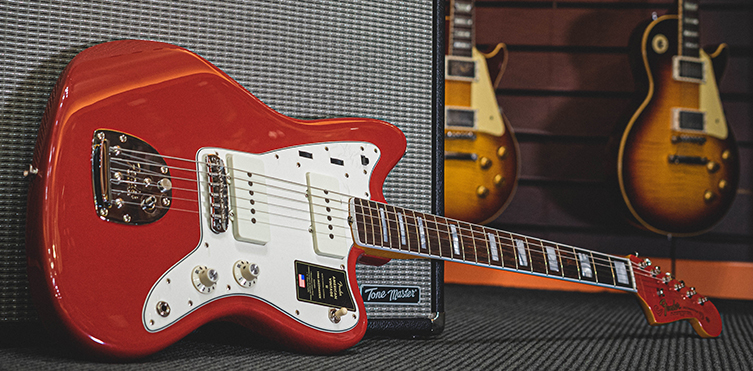
On top of that, I will happily report that I personally adore every set of Pure Vintage pickups that I‘ve tried on Fender guitars. Whether on this guitar, or on a Strat or Tele, I feel like they continually nail the actual vintage sound, which every pickup company likes making speeches about whilst delivering results that are quite different. If you want a proper vintage experience outside of Custom Shop prices, then this guitar is an enormously successful answer to your needs.
Fender American Pro II Jazzmaster
I absolutely love this guitar! The Fender American Pro II Jazzmaster gets so much right, and is offered in such a good range of finishes that you’ll be trying hard to find things not to appreciate.
On top of the classic looks and full complement of circuits & switches, there are some cool details to take in here that may tip the balance for you…
- Panorama tremolo: this operates like a regular jazzmaster tremolo, but offers a much bigger ‘sweep’, so you can whammy lower.
- Mustang bridge: a superior design, more stable and more tone thanks to the brass saddles.
- V-Mod II pickups: specially wound for each position, with a tap in the bridge unit that takes out some of the power. A great idea!
- Deep C neck profile: a genuinely excellent neck for all players.
I really love it when Fender commit to things like that bridge/tremolo setup: it’s more useful, sounds better and stays in tune more, but also looks totally normal and traditional from a glance. This, to me, is what Fender in 2025 is all about: tweaks to classics that you can feel more than see. It proves that they are constantly refining and dialling in what players actually want from their guitars, and that can only be a good thing.
Plus, with finishes such as Miami Blue and Dark Night available, these are some beautiful looking guitars! This model is not for the guitarist who wants an authentically retro experience, though. For that, look to the American Vintage II model above this one in the blog. This guitar is for serious players who needs to cover a lot of ground, and do it in style.
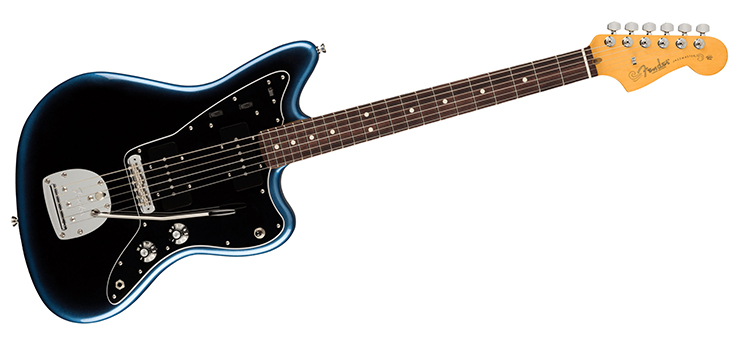
Fender Vintera II Road Worn 50s Jazzmaster
Back to vintage-land for this next one,and it’s a beauty! These Vintera II Road Worn 50s Jazzmasters are just brand new, as of time of writing, and I’m super-impressed. A nitro-finished guitar with tasteful checking over the body? A worn in neck vibe? An anodised pickguard? This is ticking lots of highly desirable boxes!
I’m going to go as far as to say that these will please fans of actual vintage Jazzmasters. Not because they are indistinguishable - that would hardly be fair given the price point - but because they deliver such a large amount of badass Fender vibe, like it’s come straight off the stage floor of CBGB’c or something. It just has that ineffable ‘mojo’ built right into it, and I feel like you’ll not take long to agree with me if you try one for yourself.
Bonus points go to Fender for including a very impressive Elite case with these.

You can also get a non-Road Worn Vintera II Jazzmaster, but I would encourage you to look at this one first. Honestly.
Fender Player II Jazzmaster
The Player II range is where the Jazzmaster goes slightly off-piste with certain features. The Player II Jazzmaster is a well-priced, very good quality guitar from Fender’s Ensenada stable in Mexico. It has the tremolo, the big pickups and the distinctive shape, but does away with the dual circuit for a more streamlined instrument.
Whilst this last part may initially seem like a strange decision, it’s worth remembering that supremo Jazzmaster fans Thurston Moore and Lee Ranaldo routinely did exactly this to their own guitars whilst using them to make history with Sonic Youth. Also, it’s smart for Fender to include at least one manifestation of this famous offset with a more simplified switching system. Despite the dual circuit being a big selling point of the JM, Fender have correctly assumed that not everybody in the world actually wants it!
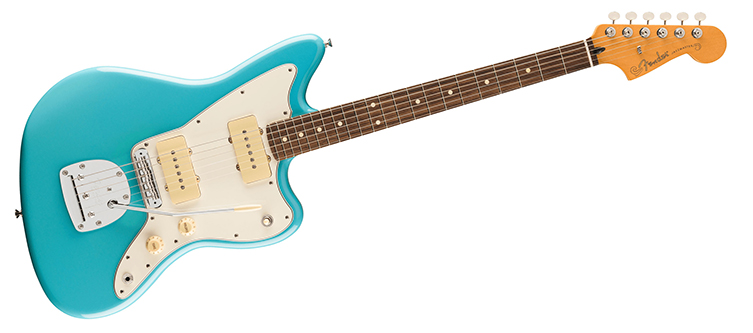
Away from that, I would highlight the following points as being significant here:
- Alnico V pickups: they sound amazing and versatile, with clarity and no muddiness
- Colour Selection: no only gorgeous, but many are unavailable outside of this range (Birch Green and Aquatone Blue, for example)
- Mustang saddles in the bridge: an essential upgrade, to be honest.
The Player II Jazzmaster is a well considered, nicely put-together guitar that brings sound, playability and good looks to the audience that needs it: gigging players who want a solid and, frankly, cool guitar to play shows with.
Squier J Mascis Jazzmaster
Do you know J Mascis from Dinosaur Jr? If not, he’s well worth checking out, but liking his playing or writing has nothing to do with appreciating this excellent signature guitar. The Squier J Mascis Jazzmaster offers a very affordable take on the JM, but without really losing most of the charm and versatility that have made the Jazzmaster such a modern day favourite.
Firstly, the combination of vintage white finish with a gold anodised pickguard is an inspired look, and one that is actually turning into a bit of a classic for those who know! Secondly, the bridge has been swapped out for a full-on Adjusto-Matic one, so you can definitely expect the strings to stay where you want them to be!
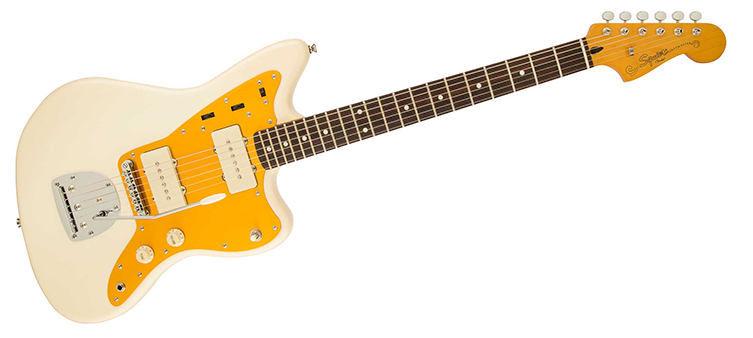
This is a guitar with a great feel, aided and abetted by a nice set of pickups and good controls with plenty of dynamics in them. It’s a fun, professional-feeling instrument that has rightfully become one of the best-selling offset models ever. I’d recommend this to all players, to be honest. If you are okay with it not saying ‘Fender’ on the headstock, then my guess is that you’re going to get on really well with this most capable of guitars.
Which One Will You Go For?
So, there is a good cross-section of the market right there. From Squier right up to Fender Custom Shop, and all points in between which say ‘Fender’ in the title, that is how the Jazzmaster world currently looks.
It has hardly felt necessary for me to compare the models - only once in fact, to highlight the modern/vintage difference - and that’s maybe the best way to deal with the subject, don’t you think? It hardly helps to say that a £4k guitar is somehow miraculously nicer than a £400, does it? I hope that’s already clear and obvious. What I did want to do was to say: ‘if you are in this particular spending bracket, this is the one I want to recommend to you. If you can spend more, check this out’. These are all personal recommendations, by the way. I’ve played all of these guitars, and what I wrote above is how I feel about them.
My choice? If money wasn’t a factor (which it always is)? The Fender American Pro II Jazzmaster. It just does more in my eyes, and to an excellent degree. I’d miss not having a nitro finish, but otherwise, I think it’s a pretty great guitar from an exceptional range.
Don't just listen to me! Judge for yourself, and head to your local guitarguitar store to try these guitars out. At the end of the day, that’s the only real way to know!
Click to View our Fender Jazzmasters

